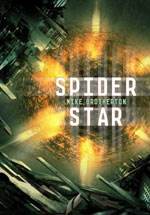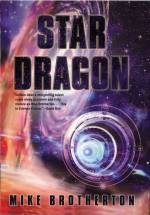Search
Ten Great Examples of Science Fiction World Building
July 28th, 2008
I am taking part in a Mind-Meld post over at sfsignal.com later this week. The subject is our favorite example of world-building. The ultimate in world-building was probably Lord of the Rings, for which J.R.R. Tolkien invented entire languages and histories. Not my favorite though by a long shot (did all the ballads and poems have to be used?), and Tolkien is likely underappreciated for his world-building since so many people have copied Middle Earth, or aspects of it, over the years, and it feels far from fresh.
As a hard sf guy, my favorite world-building tends to involve a lot more science and a lot less map making, while keeping in mind a very diverse view of world-building. I put a lot of effort into the world-building in my own novels. Star Dragon featured a biological starship and alien creatures living in an accretion disk around a white dwarf star, while Spider Star has a giant alien space station in the gravitational potential of a dark matter planet.
(Oh, and for the writers out there, specficworld has a really great list of world-building resources.)
So who/what do I love in sf for the world building?
David Brin’s Uplift Novels like Startide Rising and The Uplift War showcase a Galactic alien society and the mix is quite creative. The Milky Way seemed like a big and fascinating place. Brin did an even better job of world-building with his novel Kiln People. In that book people have the ability to make different kinds of copies of themselves, and, moreover, surveillance devices are widespread as in his non-fiction book The Transparent Society: Will Technology Force Us to Choose Between Privacy and Freedom? Both elements are well realized and integrated throughout.
Larry Niven’s Ringworld specifically, and his Known Space more generally. Ringworld is literally an entire world, a classic “Big Dumb Object” (AKA BDO), representing some of the best in sf world-building. When it was pointed out that Ringworld wasn’t stable, Niven had an excuse to write a sequel addressing the issue. Oh, and the Ringworld was cool enough to be ripped off for Halo.
Vernor Vinge’s Zones of Thought books, A Fire Upon The Deep and A Deepness in the Sky, constitute two of the best examples of building truly alien alien cultures. In the first, Vinge does a fantastic job of writing from a group mind perspective. In the latter, he has aliens who live through periods of deep hibernation.
William Gibson’s work, especially Neuromancer, established the entire genre of cyberpunk. The man invented cyberspace and has had a profound effect on our computer experiences. Apparently Gibson wrote the book on a typewriter and had not even touched a computer himself at that time.
Arthur C. Clarke’s Rendezvous with Rama gives us another fascinating alien BDO to explore. I love BDOs.
Hal Clement’s Mission of Gravity is another world-building sf classic, describing life on a heavy gravity world.
Another classic is Robert Forward’s Dragon’s Egg, about alien life and its rise to civilization on the surface of a neutron star.
The Diamond Age: Or, a Young Lady’s Illustrated Primer (Bantam Spectra Book) by Neal Stephenson represents one of the very best attempts at imagining a world based on pervasive nanotechnology.
Hyperion by Dan Simmons is a tour de force of writing and world-building, one of my all-time favorites. The time tombs, the Shrike, the lightning trees…just way cool.
One of the great masters of world-building is Philip Jose Farmer. He wrote two series that were defined by the clever worlds he invented: The World of Tiers: Volume One and the Riverworld series starting with To Your Scattered Bodies Go. These two series, and Philip Jose Farmer’s work more generally, are why I’m a science fiction writer today. I loved them.
Tune into sfsignal.com to see which I finally chose as my favorite. Hint: it isn’t Spider Star, that would be cheeky, but another great BDO.
You can follow any responses to this entry through the RSS 2.0 feed. You can leave a response, or trackback from your own site.


I found your blog a few days ago (came here from a link by Phil Plait, the Bad Astronomer, to your post on Michael Crichton) and I’m loving it so far.
About this list, I’m ashamed to say that I’ve only read Rama and Neuromancer. (Lord of the Rings goes without saying, I assume everyone has read it and loves it), but I absolutely loved Rama. Clarke’s way of describing first contact with an alien species is the best I’ve read so far.
I’m loving your blog, now I just have to finish the archives 😛
[…] Matt’s Bookosphere 7/28/08 28 07 2008 Ten great examples of science fiction worldbuilding […]
Thanks, sourman! I appreciate it. And for the record, I’ve read Lord of the Rings, although I know a few very well known sf writers who had admitted that they haven’t.
Interesting list as it reflects the Hard SF angle, whereas I read a lot of ‘science fantasy’ or whatver generic label best fits writers like Jeff Vandermeer and Gene Wolfe. For world-building my favourite is probably Jack Vance. His Gaean Reach novels are superb, as are the Dying Earth stories (in fact I’m a bit of a fan so I like pretty much all of his work). The worlds he creates are not ‘realistic’ per se, but they have a reality and powerful presence that stays long in the mind. I argue about these books a lot with my brother, who is more persuaded by the ‘hard’ style of Baxter and Banks, but he’ll come round. Finally, Olaf Stapledon is still hard to beat for the combination of weird yet utterly convincing alien worlds and life-forms. Thanks for your post – I’ll look into the ones I haven’t read.
[…] Ten Great Examples of Science Fiction World Building […]
[…] World Building 30 07 2008 A post on Mike Brother’s blog discusses great examples in Sci-Fi world building […]
Nha sach…
[…]Ten Great Examples of Science Fiction World Building[…]…
isaac asimov…
[…]Ten Great Examples of Science Fiction World Building[…]…
[…] 10 Examples of Awesome Science Fiction Worldbuilding […]